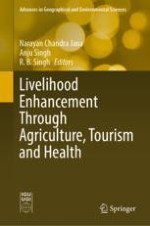
2022 | OriginalPaper | Chapter
1. Livelihood Transformations and Sustainability in India
Authors : Shahab Fazal, Deepika Vashishtha, Salma Sultana
Published in: Livelihood Enhancement Through Agriculture, Tourism and Health
Publisher: Springer Nature Singapore
Activate our intelligent search to find suitable subject content or patents.
Select sections of text to find matching patents with Artificial Intelligence. powered by
Select sections of text to find additional relevant content using AI-assisted search. powered by